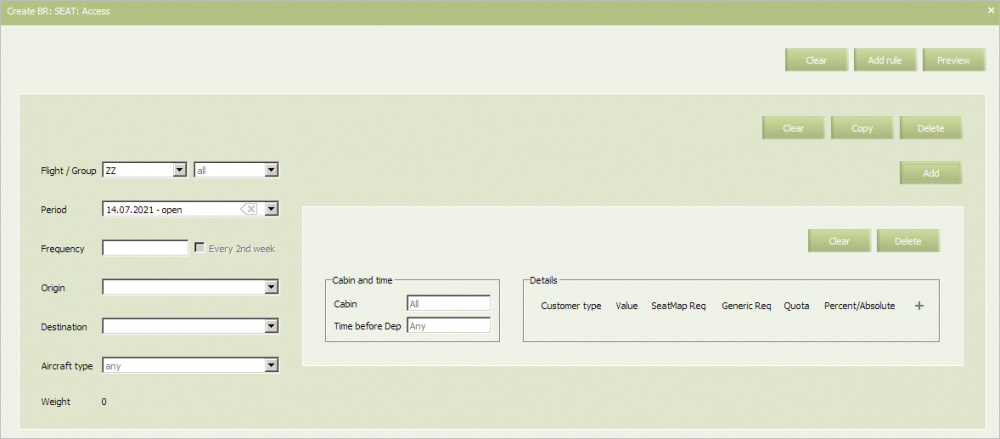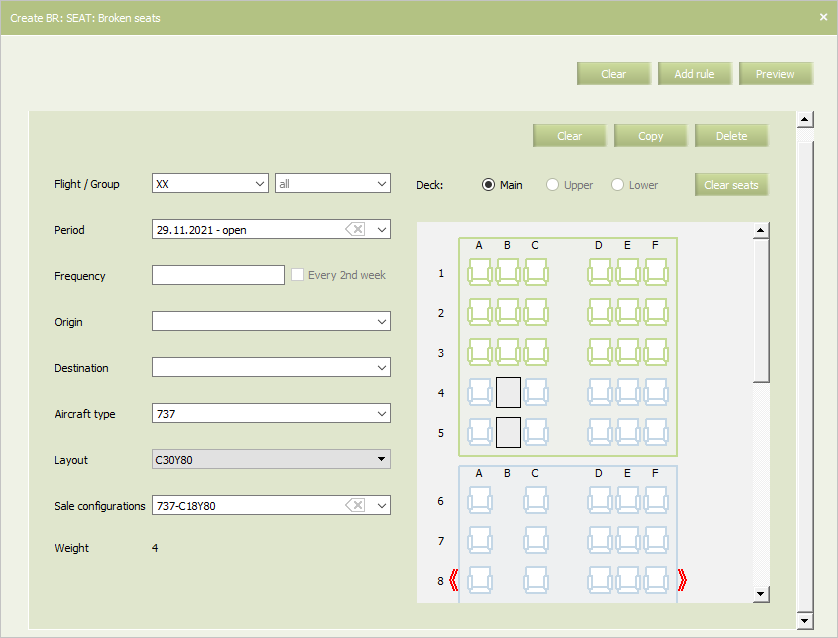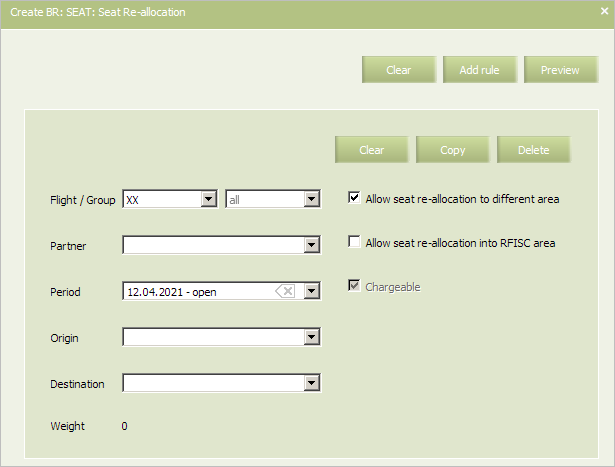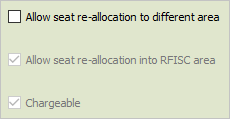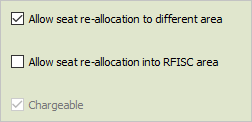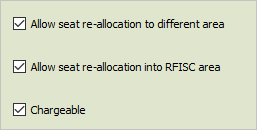Seats Business Rules
Seats Business Rules includes three rules for different system objects:
| Rule Name | Description |
|---|---|
| Access | The rule defines agent access to booking seats and seat map request via Console |
| Broken seats | The business rule defines seat blocking for cabins on a flight |
| Areas | The business rule defines special areas on a seat map — seats which are to be booked on special conditions |
| Seat Re-allocation | The business rule defines conditions of automatic seat allocation when passengers with seats are re-accommodated to another flight |
In some cases, it is required to adjust the schedule, affecting several periods of the schedule at the same time. The AVP parameter - “Adjustment validity period”. Schedule changes are applied to it for the period covered by the AVP parameter.
It is important to remember that AVP cannot contain the frequency of performance once every two weeks, the past dates, and if the original business rule does not specify the criterion of the departure frequency, AVP can not contain the frequency selection.
General information about business rules setup: follow the link.
"Access" Business Rule
The business rule defines an operating mode of the System when requesting for a particular seat on a flight (by a number or characteristics) and a seat map for a flight.
Settings of the given business rule have priority over carrier settings. The business rule is applied on a segment level of a flight schedule. If the given business rule is not set for the flight, then general carrier settings are applied.
The mandatory criteria of the business rule are:
- Carrier code
- Starting and ending dates of rule validity period.
| It is allowed to set the period that begins from yesterday. For the period editing, the System sets yesterday as the period beginning by default. |
The optional criteria of the business rule are:
- Origin and destination points
- Flight or a group of flights
- Frequency
- An aircraft type.
In the main menu, select Business rules → Business rules → Seats → Access → Create. As a result, a business rule creation form will appear.
The rule content (all the parameters are mandatory):
| Parameter | Description | Value |
|---|---|---|
| Cabin | A cabin to which access parameters are applied | One or multiple records of cabins or the “All” value are acceptable |
| Time before dep | A number of hours before flight departure within which conditions of the rule start working | Time range “from— to” in the “1440 — 0” format.
A value which is more than 1440 hours before departure is not acceptable |
| Customer type | Access conditions |
|
| Value | Value of Customer type |
|
| Seats map req | Seat map request | Allowed or prohibited |
| Generic req | Seat request in a cabin by using SSR OTHS or seat characteristics | Allowed or prohibited |
| Quota | A maximum number of seats which will be confirmed automatically for a corresponding client type (s). It is specified in percentage or absolute value relative to a cabin capacity. Requests over quota are sent in queue for manual confirmation | Percentage or absolute value depending on settings |
| Percent/Absolute | Type of quota: Percent (up to 100) or number of seats | % or seats |
"Broken seats" Rule
The business rule defines seat blocking on flights.
The rule is applied on a flight level and to all segments of a flight.
The mandatory criteria of the business rule are:
- Carrier code
- Starting and ending dates of rule validity period
| It is allowed to set the period that begins from yesterday. For the period editing, the System sets yesterday as the period beginning by default. |
The optional criteria of the business rule are:
- Origin and destination points
- Flight or a group of flights
- Flight frequency
- Sale configuration.
The rule content:
| Parameter | Description | Value |
|---|---|---|
| Broken seats | A list of seats numbers | A list of numbers of seats through a divider. For example: 1A; 1B
|
A list of broken seat numbers is specified in accordance with an aircraft layout of a selected physical configuration or using a layout of an associated sale configuration (if a sale configuration was specified as a rule criterion).
Select the seats by left-clicking on them in the graphic mock-up model on the right side of the form.
| To select several seats in the graphic mock-up model in the right part of the form, left-click them while holding the Ctrl button on the keyboard. |
To apply the created business rule, click Preview.
| If the operation is applied without specifying of flight numbers and/or with opened date, then the corresponding warning will be presented above the parameter list. |
| If the Delayed start of operations parameter's value is not 0 in the additional user settings, then the operation start will be delayed for the time specified there. During this time countdown, it is possible to cancel the operation start and return to its preview window by clicking Back. |
"Areas" Rule
Some seats on a seat map may be marked as special areas, which are to be sold on special conditions.
Areas on a seat map may be defined by “Areas” business-rule (“Seats” BR group) or manually for a specific flight on its seat map.
Areas are defined on an AC layout with corresponding physical configuration or on a connected sale configuration if it is specified as a business-rule criteria.
One seat may be used in several areas except for special cases:
- Areas of Codeshare blockspace or SSP types which cannot be both applied to one seat simultaneously
- Two different RFISC areas cannot be applied to one seat as a seat can only cost one specific price.
The mandatory criteria of the business rule are:
- Carrier code
- Starting and ending dates of rule validity period
| It is allowed to set the period that begins from yesterday. For the period editing, the System sets yesterday as the period beginning by default. |
- AC configuration
- Physical configuration
The optional criteria of the business rule are:
- Origin and destination points
- Flight or a group of flights
- Flight frequency
- Sale configuration.
The rule content:
| Parameter | Description | Value |
|---|---|---|
| Common parameters | ||
| Seats | A list of seats numbers | A list of numbers of seats through a divider.
For example: |
| Codeshare-Blockspace | ||
| MKt owner | Seats blocked in flight operator’s inventory to be sold by marketing partner. Such seats may only be occupied by flight marketing partner passengers and are guaranteed for this carrier | Codeshare marketing partner name |
| SSP | ||
| SSP | Seats excluded from free sale space to be sold on special conditions (special spaces). Such seats may be only booked while booking seats in a special space and are guaranteed for such realization | Special space name |
| RFISC | ||
| RFISC | Chargeable seat (cost of SSR “Seat request”). Before check-in is opened, window seat may only be purchased for additional cost. Such seats are guaranteed | RFISC code |
| RBD
Seats available for booking in specific RBDs only | ||
| Rbds | RBDs in which booking is available | RBDs list |
| Exclusivity | Flag that the listed seats are guaranteed for passengers of the stated RBD | Check the box to mark the seats as guaranteed for passengers in the stated RBD |
To apply the created business rule, click Preview.
| If the operation is applied without specifying of flight numbers and/or with opened date, then the corresponding warning will be presented above the parameter list. |
| If the Delayed start of operations parameter's value is not 0 in the additional user settings, then the operation start will be delayed for the time specified there. During this time countdown, it is possible to cancel the operation start and return to its preview window by clicking Back. |
"Seat Re-allocation" Business Rule
The business rule defines conditions of automatic seat allocation when passengers with seats are re-accommodated to another flight. This BR allows to define, if passengers may be automatically re-accommodated and allocated from free sale area (free seats) to comfort area (RFISC).
BR settings are checked and applied when Re-accommodation Solution is applied.
Whether the seat will be provided for a fee (with the addition of SVC HD in the order) or free (with the addition of SVC HK in the order) is determined by checking “Paid” in the business rule settings.
A rule is determined by space violation two settings:
- permission to transfer to a space other than the space in the original flight
- permission to transfer to the comfort zone space (RFISC).
In the main menu, select Business rules → Business rules → Seats → Seat Re-allocation → Create. As a result, a business rule creation form will appear.
The rule is set by two settings:
- allow seat re-allocation to different area
- allow seat re-allocation into RFISC.
In the left part of the screen you may configure a set of flights to which the rule will be applied.
The mandatory criteria of the rule include:
- Carrier code
- Period.
| It is allowed to set the period that begins from yesterday. For the period editing, the System sets yesterday as the period beginning by default. |
The additional criteria of the rule include:
- Origin
- Destination
- Flight/Group – a flight or a group of flights of the selected carrier.
The business rule has the following logic:
| Rule settings | System response |
|---|---|
| When transferring passengers of the spaces for both individual and adjacent seating,
the following mandatory term is to be met: “Space to Space” (space saving). If there is no seats in the original space, the seat will remain on request. Space violation prohibited | |
| It is allowed to transfer to a space other than the space in the original flight.
In case of impossibility to maintain the original space, the passengers can be transferred to the free sale space seats | |
| Transfer to the RFISC space is allowed. If it is impossible to maintain the original
space, passengers can be transferred to seats from the free sale space or to paid seats in the RFISC space. If the “Paid” field is checked, the seat in the RFISC space will be provided for a fee, in the absence of check – for free |
Flag Chargeable is for seat settings:
- Chargeable seat (SVC HD is added to the PNR)
- Free of charge seat (SVC HK is added to the PNR)
To view the created business rule, click Preview.
